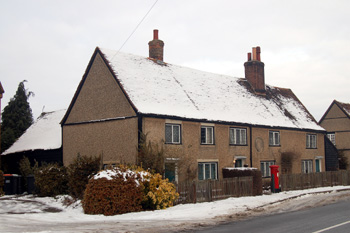
316 to 318 Cople Road - Christmas Eve 2010
316 to 318 Cople Road were listed by English Heritage in May 1984 as Grade II, of special interest. They dated the properties to about 1700. They were restored by Samuel Whitbread in 1913. They are built of pebble-dashed roughcast over a timber frame with a clay tiled roof.
We are fortunate that three surveys of the parish of Cardington from the late 18th century survive. The first of these was undertaken in 1782 by James Lilburne. He was the parish schoolmaster and later agent for Samuel Whitbread, who owned large estates in the parish and also the sole Enclosure Commissioner for the parish. He produced a list of all the inhabitants of the parish arranged by house and hamlet [P38/28/1]. This was published, with extensive analysis by County Archaeologist David Baker in 1973 as Bedfordshire Historical Record Society Volume 52.
Since publication a second list has been found [P38/28/2]. It carries revisions up to the year 1789. Sadly neither of these surveys includes a map. Finally, in 1794 Lilburne produced another survey [W2/6/1-3] and this one had a map with a key showing where each house was. One can use this to plot the houses of the previous surveys and this work was carried out by John Wood of Bedfordshire County Council’s Conservation Section in October 1982 [CRT130Cardington29].
The survey of 1782 [P38/28/1/2] recorded that the structure was then a cottage with two tenements instead of the three today. They were occupied by William Hine and Elizabeth Whiteman. William Hine was a 46 year old labourer who had been born at Clophill. He had had smallpox before May 1787. He was married to 43 year old Rosamond, née Tilcock, also born at Clophill, who spun linen; she had also had smallpox. They had three children: William, aged 11, who was schooled at the expense of Samuel Whitbread I, Rhode, aged 9, who made lace and spun Jersey, a woollen fabric often used for underwear, she became a farmer’s servant in Cardington in 1787, and 7 year old James who was schooled at the expense of Samuel Whitbread. The two older children had been taught to sing and the parents were willing for all three to be inoculated against smallpox. The family moved to another cottage in the village in 1783. By January 1786 John Taylor, a 34 year old labourer who had been born at “Alesey” i.e. Arlesey was living at the property with his 32 year old wife Elizabeth, née Thomkins who had been born in Great Barford and made lace.
Elizabeth Whiteman was a 57 year old widow whose maiden name had been Thorogood, she had been born in Bedford and kept a shop. She had a daughter, 25 year old Frances who made lace and a son, 24 year old Samuel, a carpenter who married Mary Coles from Cople, who made lace, on 2nd June 1784. Samuel died on 30th October 1785 but left a daughter, Mary, born on 28th November 1784. the survey of 1794 noted only Frances Whiteman in residence [W6/2/1-3]
The Rating and Valuation Act 1925 specified that every building and piece of land in the country was to be assessed to determine its rateable value. Cardington, like most of the county, was assessed in 1927 and the valuer visiting 316 to 318 Cople Road [DV1/C116/25-27] found them owned by the Whitbread Estate.
Number 316 was occupied by Albert Houghton who paid rent of £6/18/4 per annum. His accommodation comprised a living room, a kitchen and a pantry with two bedrooms above. Number 317 was occupied by Alfred Houghton at a rent of 1/18/11 per half year. His accommodation consisted of a living room, kitchen and two bedrooms. An Ordnance Survey map of 1970 shows this property as then being the village post office. G. Brown lived at Number 318, paying £3/16/8 per annum. He had a living room, parlour, scullery and two bedrooms. A barn stood outside this property.